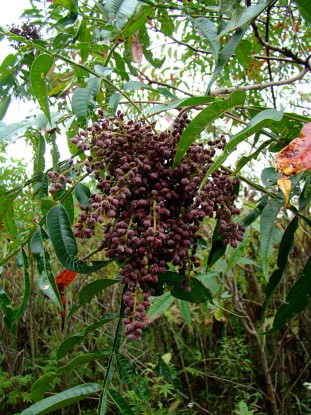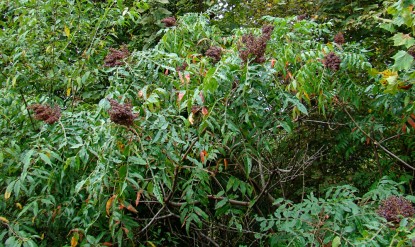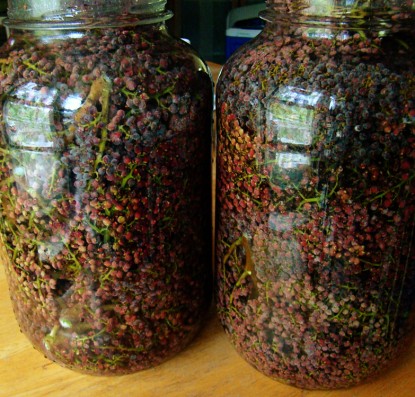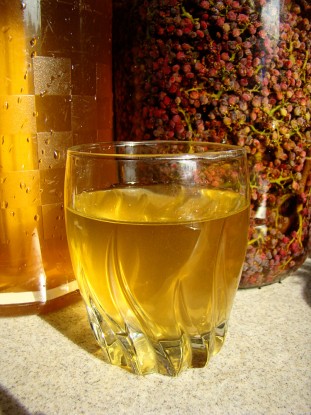
Smooth sumac bob
Smooth sumac shrubs [Rhus glabra] are invasive around here in southern Indiana. They grow from the root rhizomes–like iris do–to form large clonal colonies. These short trees get about 15 feet tall when they’re really happy. The branches ooze a white sap when cut. The good news is that they’re attractive and the ripe red berries are very useful.
The branches bloom and form dense clusters of red berries, called ‘drupes’. The name ‘sumac’ comes from the Old Arabic word for ‘red’. The cut branches make beautiful fall arrangements that will dry on their own and last for months. The dried drupes have been used throughout the world as a cooking seasoning [sumach] and they are very popular in middle eastern cooking. We harvest the drupes to make the best lemonade you can imagine.
There are two common varieties of sumac: Smooth sumac [Rhus glabra] and Staghorn sumac [Rhus typhina]. Staghorn stems and drupes are covered with fine velvety hairs. Smooth sumac is…smooth. No hairy stems or drupes. The red drupes of the smooth sumac are often covered with a milky or waxlike substance–it’s delicious!
Note: A lot of people freak out about these plants, believing that all sumac is poison sumac. Poison sumac has white or gray berries – ‘Berries white, take flight!’. Not red berries. Not red berries covered with milky wax. It’s easy to tell these plants apart. Really easy.

Sumac Spice–Dry
To harvest the drupes to use as a spice later, cut the clusters, called ‘bobs’ and lay them on screens or sheets to dry. When the drupes are good and dry, rub them off the twig and put them in jars. Save the little hairs of staghorn sumac – they’re tasty! This spice lasts for a long time.
Smooth sumac drupes are often waxy or covered with a milky substance. The flavor is in that wax but it’s tricky to get it dry enough to store. Be patient. Keep them in a very dry place and keep in mind that it will take weeks before they’re dry.
Lemonade
Our favorite way to use sumac is in lemonade.

Sumac bobs soaking for lemonade
Cut the bobs–the waxiest ones you can find–oozing the white stuff over the red [or purplish] drupes. (If you’re using staghorn sumac, then go for the hairiest ones–that’s where the flavor is.) Remove all the leaves. Do NOT wash the berries–you’ll wash the flavor off.
Pack the bobs into glass gallon jugs–pack them tightly. Fill with cool water and set them in the sun for a few hours. If the weather is cool and cloudy, then use lukewarm water and soak them overnight.
Note: Do NOT fill the jars to the top. As they soak, the bobs release bubbles and the jar will overflow if the water level is too high. You might want to put the jar in a dish to catch the overflow.
After a few hours, the water will be a beautiful light amber color. Strain the water through a fine mesh tea sieve as you pour it out of the jar. It will be cloudy for a while. Don’t worry about that. We got just over 2 quarts of juice from each of these jars.
Add 1 to 1 1/2 cups of sugar to sweeten (to taste). Stir well and enjoy. This is the best lemonade ever. I much prefer it to regular lemonade.

Freezing
I have had excellent success freezing the juice and using it months later to make lemonade with. If you can spare the freezer space, it’s worth freezing the juice.
Concentrate
To concentrate the juice, soak a gallon of bobs the first day, then use that same water to soak another gallon of bobs. Remember, the longer you concentrate, the more likely you are to introduce bad stuff into the water. I don’t concentrate unless I’m going to cook with it and it will be pasteurized in the cooking.
Canning
I have tried to can sumac juice so that I wouldn’t have to use my scarce freezer space for juice. I concentrated the juice, then I boiled it and put it into jars and processed them for canning. It worked beautifully, but the flavor was changed in a significant way. I don’t like the cooked juice nearly as much as I like the fresh juice. If I want to preserve sumac juice, I’m going to freeze it.
Experimenting
I used some of the concentrate to make sumac jelly and to make sumac lemonade bars with a lemon bar recipe. In both cases, the wonderful subtle flavor of the juice was lost. The sugar overwhelmed the flavors and the finished product was unimpressive and too sweet. This needs more investigation.
Other Uses
Sumac leaves have a lot of tannin in them. Rumor has it that they’re good for dyeing and will give either a yellow dye or grey dye depending on the fiber and mordant. Someday soon, I’m going to use the drupes and leaves to dye with. I’ll let you know how it turns out.
Robin from Rurification blogs at Rurification. Do you have a recipe post or kitchen-related story to share on the Farm Bell blog?
See Farm Bell Blog Submissions for information, the latest blog contributor giveaway, and to submit a post.Want to subscribe to the Farm Bell blog? Go here.




Teresa says:
Very interesting! We have the staghorn (hairy) sumacs in our back yard. They are very invasive, but pretty, especially in our Central PA autumns.
Thank you,I learned something early this AM!
On September 15, 2011 at 7:03 am
Pete says:
Just the encouragement I needed to investigate the sumac around here! Thanks!!
We have always been told that all our sumac is poisonous, but what do “they” know – some of it does have red berries, if you can get to them before the birds do.
Anybody know how old the tree must be before producing large, gorgeous clumps, errr, bobs?
On September 15, 2011 at 9:18 am
Normie says:
This is very cool information! Rhus glabra grows prolifically in our area (north central Florida), so I plan to give this a try. One thing, though – shouldn’t the beverage be more rightly named “Sumac-ade”? 😉
On September 15, 2011 at 10:03 am
Jennifer says:
Robin, thanks for such an informative & clear post! I had read about this in the past but the info was very vague. And for the clarification on what the Poison sumac looks like (my stepson just asked me that last weekend!). We have TONS of stag sumac in our yard (to the point its taking over the yard!)I wish we had the berries instead so I could grind them and make Zatar…
On September 15, 2011 at 10:16 am
Sheryl - Runningtrails says:
We have an abundance of staghorn sumac here too and I never knew it was edible! Thank you very much for this information!
On September 15, 2011 at 12:49 pm
Robin from Rurification says:
Hi Pete – Our trees start bearing when they’re about 8-10 feet tall – we have Rhus glabra – smooth sumac. This year we noticed a new stand of rhus which bloomed earlier and much shorter. We’re thinking it’s probably a slightly different variety [there are several] but the differences are so slight that I couldn’t tell you what it might be.
Normie – [grin]. I know. I know.
On September 15, 2011 at 7:49 pm